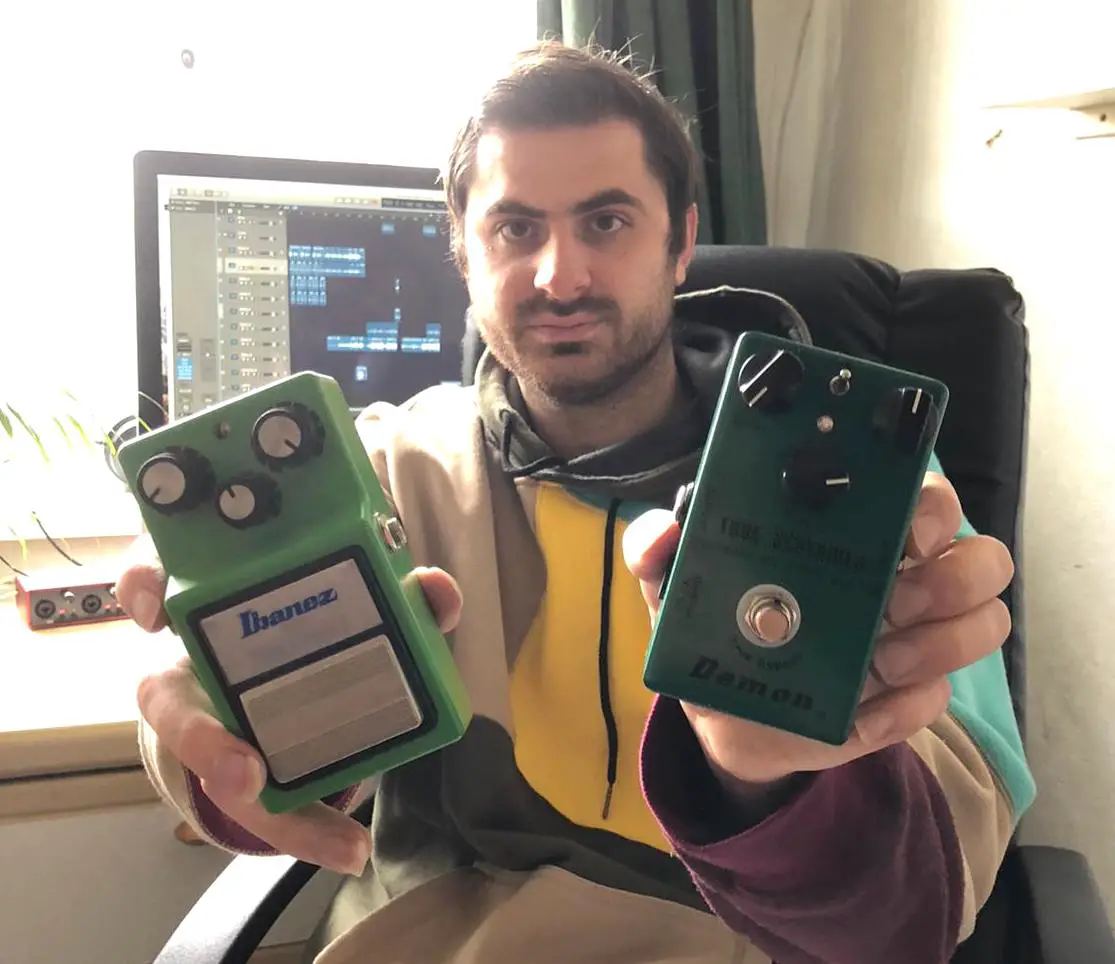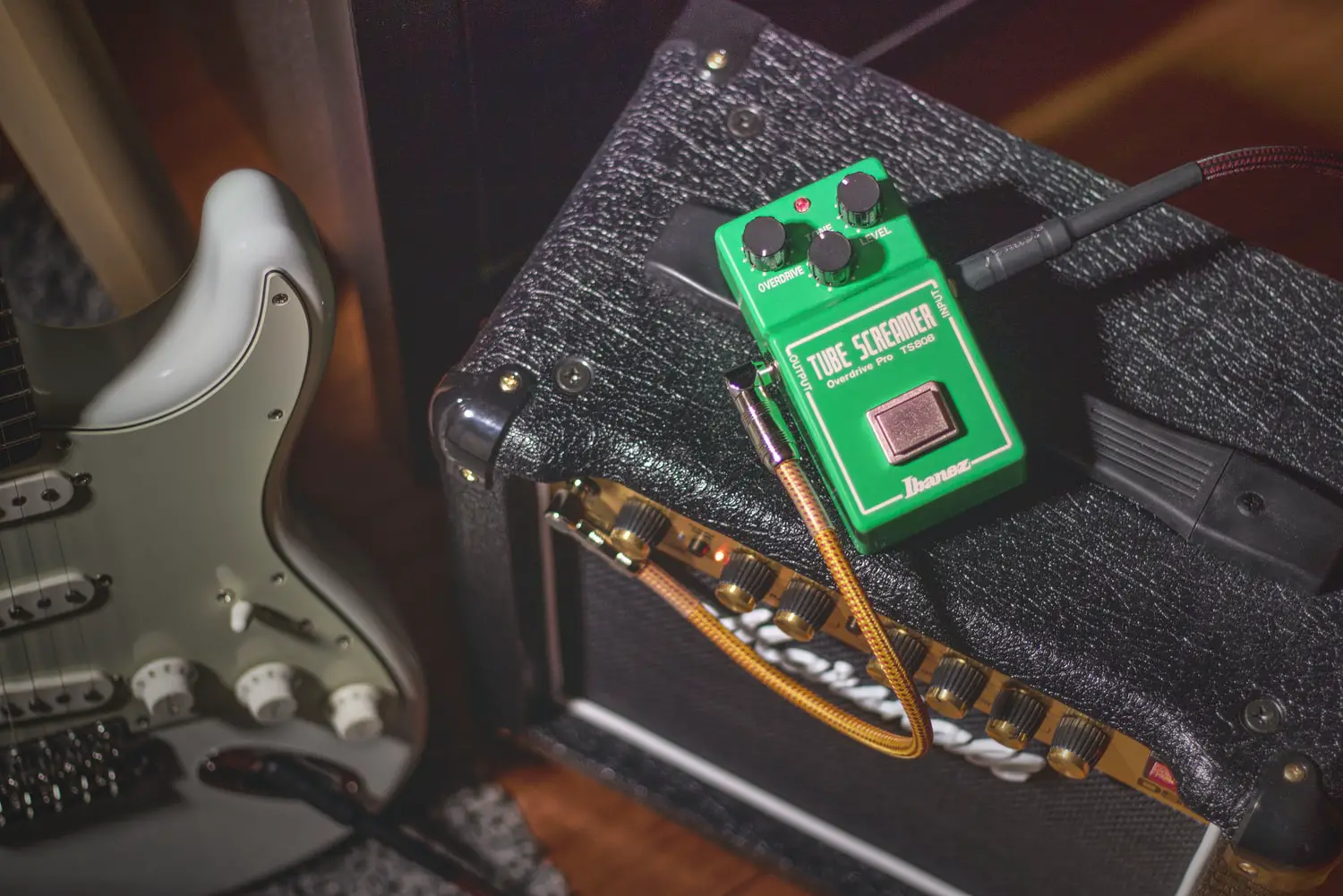Have you ever wondered how guitarists get that really big sound that cuts right through the track and just sounds fuller? I remember when I first started experimenting with effects pedals and it was really hard to transform my tone from that flat sound to a well-rounded big tone.
But, it is relatively easy once you know what you’re doing with a tube screamer. You can give your tone a big boost and sound really dynamic without any layering of tracks or compression.
[amazon box = “B000RW4WSM”]
How to use a tube screamer as a boost? To get maximum boost to your guitar tone with a tube screamer you want to get the pedals in the right order with the correct settings. Now, this is personal preference but you cannot go wrong by having the tube screamer last in the chain (before the noise gate), and having the overdrive setting set to almost zero. Find how much gain you usually use on your amp, and then turn the gain down about 2 notches as the tube screamer will compensate for this. Set your TS gain to 0 and level to just over 5/10 (a lot of people do 10 out of 10 but I really find it overkill idk).
However, there is a lot to consider when applying the tube screamer including the type of amp you are using and there are many aspects you have to negotiate to get that screamer full tone. So, let’s look into this in way more detail.
1. What Is A Tube Screamer?
A Tube Screamer is an overdrive pedal that boosts the sound of a guitar by tightening the tone input and pushing the guitar amp to overdrive.
This is beneficial because it makes your amp work harder at lower volumes to reach the point where the amp breaks up naturally. By breaking up we mean to the point where the amp produces a distortion affect.

But, why don’t I just use distortion or overdrive pedal effects? There are many other options to achieve this but when you use effects never nearly sounds as good as when you get the amp to break up naturally.
By trying to get this effect without a Tube Screamer you have to crank the amp to get the best tone imaginable and as you can image these amps go very loud so its not always ideal.
2. How Much Control Does A Tube Screamer Give You?
A Tube screamer can be used to control low, mids and tops of your sound that your amp cannot deal with. By using a tube screamer the right way and knowing how to control these frequencies in contrast with your set up can help:
- Boost clarity
- Increase brightness
- Reduce Muddy
- Boost Clean Channel
- Boost Dirty Channel
- Boost Volume
Depending what you want to achieve will be different for every set up. So, it is important to understand how the tube screamer works so you can get the best out of the equipment at hand.
Let us look at these essentials in more detail.
3. Controlling the Bottom-End Frequency
First off, the boost cuts some bass, with some amps when you start to crank it. This is good because when you start to crank the amp it can begin to get a bit muddy or smeary sound once you boost the gain.
The Tube Screamer gets rid of that smear and lets you run the gain lower at the amp. You can essentially get an extra channel from your amp when doing this. The channel can go from a sort of hard rock channel to a tight metal channel.
4. Controlling the Mid-End Frequency
Tube screamer clarity is a terminology you need to know when understanding tube screamers, whereby the clarity comes from the mid tone.
By clarity we mean how clear can you hear your guitars true tone among other instruments. You come to notice that your guitar tone sounds clear at first until you are playing in a band scenario or recording then your tone will sink into the background and feel as if it is under the other instruments. You can use your tone knobs on your amp, but you aren’t always boosting that cutting upper mid frequency by turning the treble or presence knob.
A guitars most true tone is within its mids and a Tube Screamer will tighten the mid-range which will result in a slightly louder, but more powerful output in this frequency. This will naturally make the guitar heard more against a bass and drums for example. Not only will it be heard more, but hear more of its natural quality tone.
Overall, a Tube Screamer will give you clarity by providing a boost to the mid-range and providing you with the option to boost the upper mid/presence range.
To NOTE: It is also said that adding overdrive can make the amp sound dirty and reduce clarity? But, the tube screamer works in the opposite way because by making the amp work harder it produces a natural overdrive when the amp reaches the point of break up. So, you want to hit the amp harder so that it starts clipping, if you want more clarity. In addition, you can turn down the gain on your amp as the effects types of gain can be muddier. Clipping is a form of waveform distortion that occurs when an amplifier is overdriven and attempts to deliver an output voltage or current beyond its maximum capability.
5. Controlling High Frequencies With A Tube Screamer?
Cutting out harsh high frequency harmonics seems to be one of the underlying principles of the Tube Screamer. These harmonics are unwanted sounds that appear in the high range frequency. This is because by turning the amp volume up it brings the amp to clipping which produces overdrive. However, the vibrations of the overdrive can produce some unwanted harmonics.
A Tube Screamer will make the amp work harder to produce overdrive but the vibration of the unit is not as loud that it produces unwanted harmonics. In addition, they act like a first order RC low pass filter that cut out the harsh high-frequency harmonics. Overall, if set up correctly a tube screamer will shape the highest harmonics, making them more pleasing to the ear.
6. Tube Screamer Or EQ
As discussed from the previous three sections we have spoken about how a Tube Screamer can control the low, mid and high frequencies which produce its awesome sound.
This is the exact job of the EQ for example; you can boost the mids and shape and scoop out unwanted harmonics with an EQ… and so the questions becomes, as it is most often asked… Why wouldn’t I just use my amp EQ for that and not spend money on a pedal that may cause harm to my tone?
By using a Tube Screamer you would tighten things up and take out some bass, boost some mids. But, an EQ would give you more control on shaping your tone (especially if you had a multi band EQ).
It will always be a good idea to have both and experiment. Also, you would usually expect to see your eq at the beginning of the signal chain. But, there is also no fixed rule for this, especially if you want to get creative!
7. Positioning the Tube Screamer
When using a tube screamer to can accomplish different sounds depending where you position it in your effects board. The typical things you want to achieve is boosting clean signal, boosting dirty channel.
The idea here is not to generate artificial overdrive in the pedal and layer it on top of the amp’s clean sound, but instead force the amp into natural overdrive with which the pedal’s sound can blend.
Using A Tube Screamer to Boost Clean Signal
If you just want a volume boost to your clean signal then you want to put it after the distortion pedal. If you boost before the distortion you will alter the drive characteristics when you engage. If you are going from full chords to single note runs and therefore want to increase drive and volume, put it before.
Using A tube Screamer to Boost Dirty Signal
A Tube Screamer has some dirt even when the gain is on 0, it then mixes the clean signal with the distorted signal at the output.
But, you get extra gain that sounds cleaner because of the break up of the amp. So you need to bear this in mind when dealing with distortion, as you do not want too apply too much.
If you boost before the distortion you will alter the drive characteristics when you engage. If you are going from full chords to single note runs and metal style palm muting and therefore want to increase drive and volume, put it before.
However, you can try putting in the pedal after distortion. But, this also means if you are using an amp with distortion built in then you will want turn down the distortion on the amp and add an extra pedal before.
8. Behringer VS Ibanez Tube Screamers
The two closely matched tube screamers has to be between the Ibanez and Behringer pedals.
In the this video they give a direct comparison against and you can see and hear for yourself.
[amazon table=”3726″]
I am a big fan of the Ibanez tube screamer pedal, they was the original and have a really nice classic sound to them. For this it would always be my first choice. However, the Behringer is a close second and not surprisingly the behringer sounds slightly more squeezed. I think the that it may have more natural compression.
Overall, they are both good, both tighten up the mid and both add that nice warm gristly texture to your tone!
9. Guitars That Benefit The Most From Tube Screamer
7 strings or down tuned guitars benefit really well if you are looking for that decent sound and will still improve more than with your standard tuning. But it will still have a positive effect if set up right on any guitar.
Conclusion
Overall, I have never been able to replicate the sound of Tube screamer using EQ and amp controls by themselves, by which the sound the tube screamer produces is an almost essential effect for most modern metal sounds.

